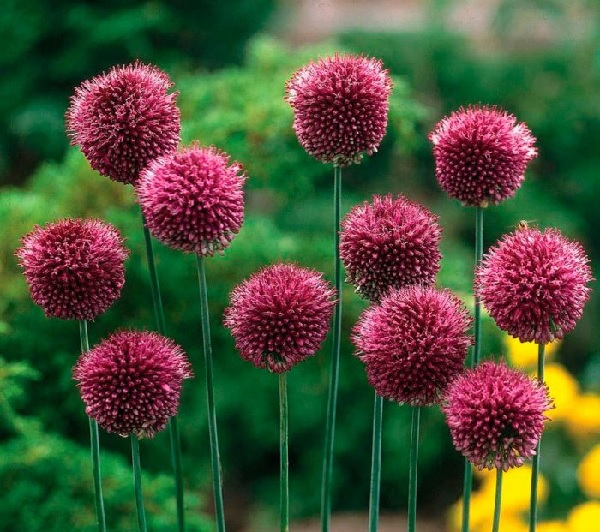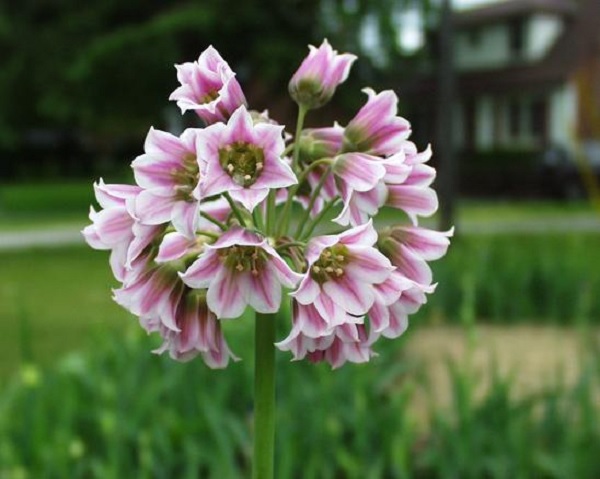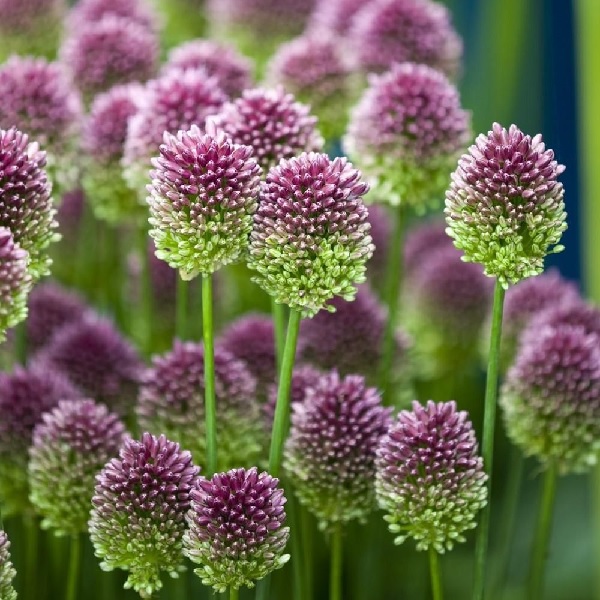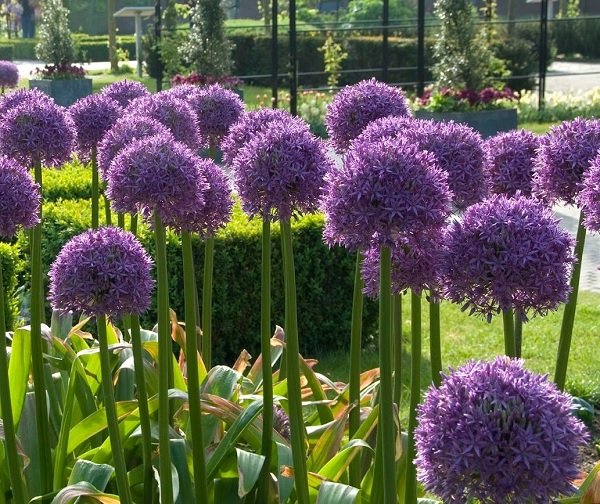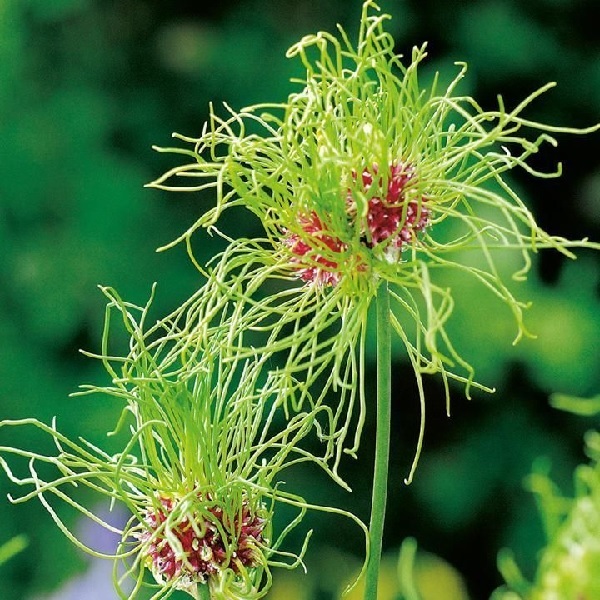Allium bow
Content:
A decorative bow can become a real garden decoration. Many gardeners tend to underestimate it. Meanwhile, the genus Onion (in Latin "Allium") belongs to the Liliaceae family and looks no worse than its other representatives.
Allium - decorative onion: popular types
In wildlife, the allium (decorative onion) has about 700 species. They are common throughout the Northern Hemisphere, but are most commonly found in the Mediterranean and Asia. Only on the territory of the European part of Russia there are more than 40 species that can grow in the wild in a variety of conditions: in river valleys, forests, deserts and even on rocky slopes.
Allium has been cultivated for over 300 years. At the same time, about 40 species of this plant and many of its varieties are used in modern landscape design.
All cultivated species of allium are perennial herbaceous plants, the bulbs and rhizomes of which can remain in the ground for several years, while their aboveground part dies off.
Although the appearance of different varieties can vary greatly, their leaves are always juicy and fleshy. But their shape can be very diverse: there are flat, grooved or cylindrical leaves. Their width varies from 1 to 15 cm. In addition, the height of plants can also be different: they can be undersized up to 15 cm, or they can reach 1.5 m.
Decorative bulgarian onion
This species is one of the most beautiful. Its bush can reach a height of 0.9 m. The decorative Bulgarian onion blooms very beautifully. Its inflorescences resemble large balls collected from white-pink bells.
Allium Gladiator
This variety grows up to 100 cm in height. The leaves are dark green in color. Allium Gladiator blooms with flowers resembling a star and having six petals each. They are distinguished by an unusual blue-lavender shade and a pleasant, slightly sweet scent.
Its inflorescences are quite large, can reach a diameter of 20 cm, and sometimes even more. This type of ornamental bow looks especially good in rockeries and alpine slides. As for companions, they can be grown next to bearded irises.
Globemaster
The Globemaster is a very unusual decorative bow. It reaches a height of 90 cm, and its inflorescence is considered one of the largest in the family. Its diameter is about 20 cm, but it is amazing that it is collected from more than 1500 small star-shaped flowers, which makes it very thick and heavy. Therefore, the stem of this variety is very strong so that it can withstand all the vagaries of the weather, whether it be rain or wind.
The allium Globemaster bloom period begins in the second half of May. It is then that its purple-purple flowers open up. Flowering continues for about a month.
Allium Purple Sensation
Another type of decorative bow is the Purple Sensation hybrid allium. It differs in relatively low stems up to 70 cm in height. But its leaves are large, up to 4 cm wide.
Allium Hair
This is the most unusual type of decorative bow. The stem height of the Hair allium is about 130-140 cm.
Its inflorescences are called balls, but very conditionally due to the unusual shape of the flowers, resembling disheveled hair. The diameter of such a ball is relatively small, about 7-8 cm, but it looks very impressive. The inflorescences are greenish in color, but their core is pinkish.
Allium Sphaerocephalon
Allium roundhead (Sphaerocephalon) is another popular variety of ornamental onions. Its peduncle reaches a height of 60 cm. Its bulbs are small, about 2 cm in diameter, differing in their ovoid shape.
The inflorescences of this variety are very dense rounded umbrellas. They can be up to 4 cm in diameter. Umbrellas consist of a large number of small flowers that resemble bells. Their stamens are slightly longer than the petals, so from a distance, such inflorescences seem fluffy. The buds of this round-headed variety are green in color. But after opening, their color changes to a pronounced red-violet palette.
Allium White Cloud
Allium White Cloud has another name - grape onion. Thanks to the strong, as if slightly swollen, stem and large white spherical inflorescences, and in fact resembling a cloud, it will become a real decoration of the garden. In appearance, the plant is a bit like the white flowers of the Mount Everest allium, another variety of ornamental onions.
The "cloudy" variety blooms rather late in comparison with other varieties, it blooms only in June. But it pleases the grower until September.
Allium Giganteum
In the allium Giganteum (or giant onion), all parts of the plant are striking in their size. So, the diameter of the bulb is at least 5-7 cm, green or more often bluish-green leaves reach a width of 10 cm, and the height of the peduncle is 150 cm. But the blooming umbrella itself is relatively small, 10 cm in diameter. But it is very dense and consists of many star-shaped flowers that have a purple color. This variety blooms in late May. The most popular variety is Rose Giant.
Allium Moli
Allium Moli has several names, including golden bow. Indeed, it differs from most other varieties in both the height of the bush and its appearance. The stem of the plant reaches a height of only 25 cm. Its leaves are flat, they do not have a very expressive gray-green color. But the flowers themselves are large, yellow or even golden in color. Tepals gleam beautifully. This variety blooms in June, giving the garden a very elegant and festive look.
Allium Blue
The main feature of the allium Caeruleum is its bright blue inflorescences. The diameter of the inflorescence is up to 5 cm. Moreover, in these bright blue balls, along with flowers, a kind of buds can form, resembling balls or bubbles, so even botanists call them bulbs. As the peduncle develops, they can change color from blue to pink.
Neapolitan bow
The unusual shape of the peduncle can also boast of such a variety as Neopolitanum, that is, the Neapolitan decorative bow. Its stem reaches a height of 50 cm. Peduncles have the shape of a hemispherical umbrella, consisting of beautiful pale pink flowers, rather large. There are, however, varieties with snow-white flowers, however, some botanists tend to single them out as an independent species.
There are many other interesting varieties of decorative bows. For example, allium Schubert has a peduncle diameter of about 30 cm.Moreover, all its pedicels have different lengths, which is why the flower as a whole seems loose, although it looks very impressive. Allium Millennium has its own advantages, the height of the bushes of which is only 40-50 cm, but the inflorescences are quite large and dense.
Is it possible to eat decorative allium bow
Not all types of onions can be eaten. Also, keep in mind that they can taste even more pungent and pungent than the common green onions used for salads. Allium Gladiator is considered the closest to him. Also in cooking, blue decorative onions are used.
Allium White Cloud contains many essential oils, but they give it a rather pungent onion taste and smell. You can eat its stems, but this is a seasoning for an amateur. But, for example, Aflatun decorative onions should not be eaten at all.
Features of agricultural technology
Allium bulgarian, blue, and Neapolitan onions have no special requirements for soil or air humidity. But in general, all types of ornamental onions grow better on loose soils, neutral or slightly alkaline. Growing such flowers is a task that even a novice florist can cope with, you just need to study the basic rules.
Disembarkation and leaving
This plant requires a soil with enough moisture, but loose, to avoid stagnant water, because it can lead to rotting of the bulbs. It is also important for an ornamental onion to choose a well-lit place, since most varieties are photophilous (in partial shade, perhaps the Moli onion feels good, but it also grows well in open space). And when choosing a place, you need to take into account the general layout of the garden.
Before you buy seeds of a particular variety, you need to carefully read the description. Some varieties are suitable for cutting, you can make beautiful bouquets with them. It is also important to find out next to which flowers they can grow.
Almost all varieties of ornamental onions are frost-resistant. However, there are varieties that, in the conditions of the Moscow region, must certainly be covered for the winter.
These plants do not require special care. The main thing is to loosen the soil around them in the spring in order to create favorable conditions for the development of roots and leaves. Mineral fertilizers are also applied in the spring. But organic is not recommended at all.
Caring for this plant also involves watering them regularly. If the decorative onion lacks moisture, its leaves stop growing, and there will be no talk of a beautiful flowering.
Plant propagation
There are two ways to propagate a plant - by seeds and vegetative. The latter involves the use of ordinary bulbs or babies - small bulbs that form on the bulbs themselves.
In general, ornamental onions can grow for a very long time in the same area, forming very beautiful thickets, but experts do not recommend allowing such an overgrowth, since in this case, over time, the bulbs will inevitably become smaller, and the plant will no longer bloom so beautifully. Therefore, in order for the plant to develop well, it is recommended to divide and replant it at least every four years, and even better a little more often.
In the conditions of Central Russia, experts recommend carrying out such a procedure annually. The fact is that most of the varieties and varieties grown in the country grow in the wild in Central Asia, and this region is characterized by summer droughts and frequent thaws in winter.This means that these plants are not adapted to stay in moist soil after rain for a long time during the summer. Namely, these climatic conditions are typical for the second half of summer in most of the European territory of Russia. To prevent the bulbs from starting to rot, they should be removed from the ground.
The question arises when to dig up allium. Experts say that this should be done after the leaves die off. The dug out bulbs should be dried, after which they can be safely stored indoors (and with good ventilation) until planting. This is done in the fall, maximum at the end of October, if the weather conditions permit: there must be a stable temperature and dry weather. The planting depth of the bulbs can be up to 20 cm. The distance between them, depending on the variety, can be from 5 to 25 cm. Large bulbs should be planted deeper than smaller ones.
Planting the seeds of the plant is carried out in the fall. The fact is that in many varieties, seeds literally need a little freezing for better germination. But you should not think that after a year or two you will be able to enjoy flowering. Seedlings bloom not earlier than in the third or even fourth year, and sometimes even later. But if everything was done correctly, their flowering will be a real joy for the grower.
Thus, decorative onions are not just a garden decoration, but also a delicious seasoning that can be used when preparing salads. Isn't it a universal culture for a summer resident ?!
